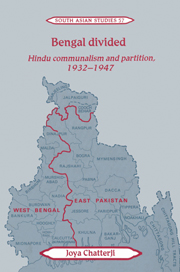Book contents
- Frontmatter
- Contents
- List of maps
- List of tables
- Acknowledgements
- List of abbreviations
- Glossary
- Map 1 Bengal districts
- Introduction
- 1 Bengal politics and the Communal Award
- 2 The emergence of the mofussil in Bengal politics
- 3 The reorientation of the Bengal Congress, 1937–45
- 4 The construction of bhadralok communal identity: culture and communalism in Bengal
- 5 Hindu unity and Muslim tyranny: aspects of Hindu bhadralok politics, 1936–47
- 6 The second partition of Bengal, 1945–47
- Conclusion
- Appendix
- Bibliography
- Index
- Cambridge South Asian Studies
5 - Hindu unity and Muslim tyranny: aspects of Hindu bhadralok politics, 1936–47
Published online by Cambridge University Press: 04 August 2010
- Frontmatter
- Contents
- List of maps
- List of tables
- Acknowledgements
- List of abbreviations
- Glossary
- Map 1 Bengal districts
- Introduction
- 1 Bengal politics and the Communal Award
- 2 The emergence of the mofussil in Bengal politics
- 3 The reorientation of the Bengal Congress, 1937–45
- 4 The construction of bhadralok communal identity: culture and communalism in Bengal
- 5 Hindu unity and Muslim tyranny: aspects of Hindu bhadralok politics, 1936–47
- 6 The second partition of Bengal, 1945–47
- Conclusion
- Appendix
- Bibliography
- Index
- Cambridge South Asian Studies
Summary
In the late 1930s and 1940s, bhadralok politics underwent changes that corresponded, in interesting ways, with the ideological shifts that have been discussed in the last chapter. Most marked was the tendency to shun high nationalist endeavour and to focus instead on narrower, more immediate concerns. Perhaps the most ambitious scheme to attract the energies of the bhadralok in these years was the attempt to forge a greater Hindu political community, uniting the disparate castes and tribes of the putative ‘Hindu family’ into a single harmonious whole. But, generally, bhadralok politics grew more inward-looking and parochial, increasingly confined to the petty manoeuvrings of the localities and District Boards. This trend was particularly marked in traditional bhadralok strongholds in the west Bengal heartland where a growing Muslim influence had begun to erode established patterns of dominance. This chapter looks at these new orientations in bhadralok politics and examines their implications for communal relations in Bengal.
Caste and communal mobilisation
Since the turn of the century, ideologues of Hindu political unity had advocated programmes for the uplift of untouchables and the breaking down of caste barriers. Swami Vivekananda had looked forward to the coming of the age of Truth (Satya- Yuga) ‘when there will be one caste (Brahman), one Veda, peace and harmony’. But Hindu unity remained a distant dream to Sarat Chandra Chattopadhyay, writing in 1926. In his Bartaman Hindu–Mussalman Samasya, he had argued that the most pressing task before Hindus was to ‘achieve unity within their own community’ and to bring an end to the practice ‘that has long distorted Hinduism – of insulting some people by calling them low caste’.
- Type
- Chapter
- Information
- Bengal DividedHindu Communalism and Partition, 1932–1947, pp. 191 - 219Publisher: Cambridge University PressPrint publication year: 1994
- 2
- Cited by

